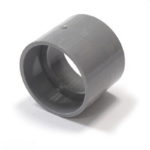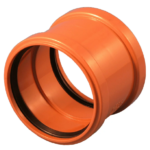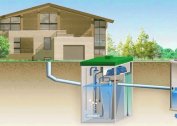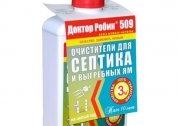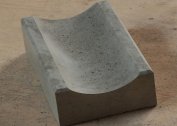Sewer couplings are shaped parts for connecting pipeless pipe sections in sewage systems. They provide tightness and strength of the pipeline at the joints. Using couplings, you can assemble a new highway and repair damaged sections of existing sewage networks.
Application area
Depending on the scope of use, coupling products are classified as connecting, repair and fireproof. The first are divided into three types:
- transition products for the installation of an internal sewer network;
- connecting elements used to create the external pipeline;
- compensation inserts.
The latter are used in all types of pipelines where linear expansion is to be leveled. Dismantling inserts compensate for it by adjusting the stroke length.
The connection of the toilet to the sewer outlet is often performed using a special cuff, which is corrugated in the production. This allows you to give her flexibility and save space in the bathroom.
Fire couplings prevent open flames from spreading through the main pipes. Externally, this device looks like a metal cylinder with a special liner. The latter is made of fire-resistant material, which swells under the influence of high temperatures. Due to this, the clutch seals the line during a fire, preventing the further advancement of flame and smoke. Installation of fire-fighting elements is required on all polymer highways of the building.
Fittings are fixed on load-bearing walls or ceilings. Their installation is quite easy, it can be performed at any stage of construction and installation works.
The sliding coupling for repair is longer than conventional connection elements, and is used to replace damaged parts of the main pipes, as well as the installation of additional fittings. Sometimes, instead of it, repair work is carried out with the help of a compensating branch pipe in combination with a sewer coupling.
Classification of sewer couplings by connection type
Shaped elements are divided as follows:
- With threaded joint. It is used to create drainage systems of a small section. Often, this type of connection is mounted on pipelines under a sink in the kitchen or a sink in the bathroom.
- With rubber o-ring. Most often used in highways for sewage disposal. Advantages - quick and easy installation without the use of special tools or additional materials.
- On glue. In this case, there is no thread on the coupling or a special rubber seal. Tightness at the joints of parts is achieved through the use of a special adhesive composition. Fixing pipe pieces to glue is not allowed to be used in the sagging places of the pipeline.
- Threaded
- Glue
- With rubber seal
The most durable type of connection is welding. It can be used for pipes made of metal and plastic. The downside is the need to use special equipment. This limits the use of such a docking method at home.
Materials of manufacture
Shaped elements are made of plastic and metal: cast iron, steel, brass, copper. Steel products and models that are made of non-ferrous metals are rarely used at home because of their high cost.
The cast iron element is a wide, detachable clamp with a rubber gasket.For installation, it is disconnected, put on a damaged area and tightened with bolts.
- Copper
- Steel
- Cast iron
- Brass
Plastic models are selected depending on the material of the main pipes. They can be polyvinyl chloride, polypropylene or can be made of low pressure polyethylene (HDPE). Most often, PVC pipes and corresponding shaped elements are used for installing home networks. They have many advantages:
- Resistance to aggressive environmental influences, rust and temperature changes.
- Safety for humans and the environment.
- Durability. When following the operating conditions, the pipes can last more than half a century.
- Significant throughput. Smooth inner walls reduce the possibility of congestion.
Light weight facilitates transportation and installation: the use of heavy vehicles and special equipment is not required, which significantly reduces costs. The elements themselves are cheaper than any other analogues.
Separately, it is worth mentioning the rubber sewer coupling. It is used to connect parts of the system made of different materials, for example, polymer and cast iron.
Size range
Shaped parts are available in various sizes: they correspond to the cross section of the joined sections of the pipeline. The most popular couplings for sewer pipes with a diameter of 50 and 110 mm. But if necessary, other options are used.
Correspondence of dimensions - length and cross section - transitional sewer coupling in millimeters:
| Type of sewer network | Section | Length |
| Outdoor | 110 | 117,3 |
| 160 | 147,8 | |
| Inner | 50 | 87,1 |
| 110 | 113,7 |
Elements of repair couplings for internal sewerage have similar dimensional characteristics.
Overall ratios of sliding fittings for installation outside the building differ:
- The length of products with a cross section of 110 mm is 12.2 cm;
- 160 mm - 17.2 cm;
- 200 mm - 21.2 cm;
- 250 mm - 25 cm;
- 315 mm - 29.3 cm;
- 400 mm - 32.4 cm;
- 500 mm - 36.2 cm.
When connecting the cuffs with other shaped elements, the cross section is not taken into account for the pipe segments themselves, but for the outlet of the tee or cross. Its diameter may differ from the size of the main line.
Installation Rules
 Mounting of couplings depends on the availability of sockets - one or two - and the material of manufacture. The easiest way to connect the pipe segments with bell-shaped shaped elements made of plastic. The principle here is simple: you should firmly insert the end face of one part into the socket of another.
Mounting of couplings depends on the availability of sockets - one or two - and the material of manufacture. The easiest way to connect the pipe segments with bell-shaped shaped elements made of plastic. The principle here is simple: you should firmly insert the end face of one part into the socket of another.
Installation of repair elements
Work is carried out in the following order:
- The pipe is cut in the right place or the damaged part is cut out.
- A repair sleeve is put on the bottom piece of pipe. Its outer cut must be pushed until it is flush with the pipe end.
- A clutch with a longer bell is put on the upper end in a similar way.
- An intact pipe section or the desired fitting is inserted between the fitting elements.
- A sleeve with an elongated socket is moved down, and a repair one is moved up, connecting all the parts into a single unit.
Part of the pipe installed between the couplings requires processing. To do this, the bevel is removed at the ends, then they are coated with technical grease. This ensures that the system will not leak after repair work.
In difficult cases, it is worth using a silicone sealant, pumping it d the end parts of the couplings. After the composition dries, the probability of leaks is reduced to zero.
Nuances of working with cast iron couplings
 The main difference here is in sealing the bell joints. It runs like this:
The main difference here is in sealing the bell joints. It runs like this:
- Pipes and fitting element are set in position.
- Details are fixed by collars.
- A hemp strand impregnated with a bitumen composition is placed in the bell with the coiling of each coil or a graphite oil seal.
Externally, the bell is sealed with cement or a cement-sand mixture in a ratio of 1: 1.
Installation of sealing lips
 Sealing elements are usually installed in the socket. After that, a small section of pipe section is inserted into them with little effort. It is more difficult to install an element between the shelf of the tank and the toilet. This is done as follows:
Sealing elements are usually installed in the socket. After that, a small section of pipe section is inserted into them with little effort. It is more difficult to install an element between the shelf of the tank and the toilet. This is done as follows:
- The cuff is put on a smaller pipe length.
- The wide part of the shaped element is wrapped in a narrow one.
- The connected elements are put into working position.
- The wide part of the cuff is deployed so that it wraps around the narrow one.
Before putting on cuffs, the joined details need to be cleared of any pollution. With an uneven surface of the socket, the sealing part is mounted using silicone sealant.
Modern shaped elements are installed very simply and do not require specialized equipment. When choosing couplings of any type, you need to check that there are no cracking on their surface, especially at the ends. In the presence of chips, it is impossible to achieve the tightness of the line for sewage.


